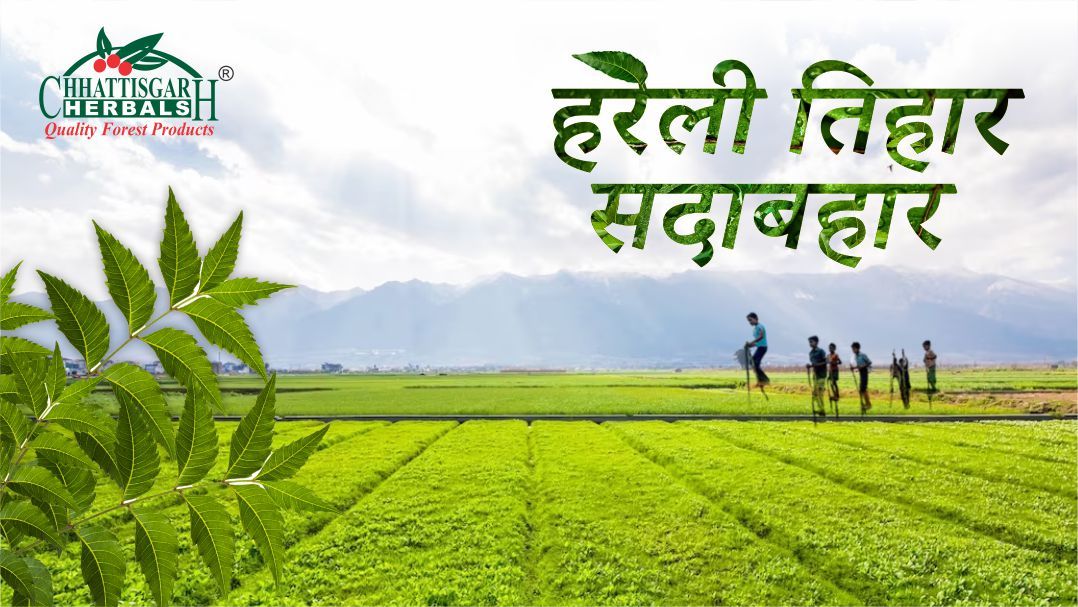Hareli Tihar: A Celebration of Life, Community, and the Bounty of the Earth

In the heartlands of Chhattisgarh, there is a time of the year when the fields are painted in vibrant hues of green, golden, and amber. It is a season that brings immense joy and gratitude to the hearts of the people. This auspicious occasion is "Hareli," a festival that celebrates Mother Nature's bountiful harvest and blessings.
The word 'Hareli' comes from 'Haryali' in Hindi which means greenery. The Goddess 'Kutki Dai' is the foremost deity worshiped during this festival for good crops. It is a festival celebrated by the various communities of farmers in the month of Shravan but is of special importance among the Gond tribes. Hareli in Chhattisgarh occurs on the new moon day of the month or the Sravana Amavasya, parallel to July and August. The word "Hareli" itself signifies the arrival of the monsoon season and the lush greenery that it brings. It is a time of rejuvenation and hope, as the fields are ready to yield their precious gifts.
Activities During Hareli Festival:
Gedi Race
The farmers of Chhattisgarh worship the equipment used for farming and cows in the Hareli festival. The theme is mainly nature-centric during the entire celebration. One of the most popular activities during Hareli is the gedi race. Gedi is a simple wooden cart that is used by children in Chhattisgarh during the Hareli festival. The cart is made of two bamboo poles that are tied together with a rope. The poles are then mounted on two wheels, which can be made from anything from old tires to logs. The children of Chhattisgarh love to ride the gedi. They ride it around the fields, and they also take part in gedi races. The bamboo poles represent the new growth that is happening in the fields, and the wheels represent the sun and the moon. The Gedi is a reminder that the new season is a time of renewal and hope.
Beginning Of the Dusshera Festival
Every year, on Hareli Amavasya, the enchanting Pat Jatra commences, signaling the beginning of the respected Bastar Dusshera festival. This 75-day-long celebration, cherished by the tribal communities of the Bastar region, pays homage to the esteemed goddess Danteswari. Pat Jatra, a sacred ritual, idolizes the Sal tree wood, lovingly called 'Thurlu Kotla' or 'Tika pata' in the local dialect. Amidst offerings and traditions, this ceremony honors the profound significance of wood and forests in the lives of tribal people. After worshiping the sal wood, it is used to craft essential tools like hammers. These tools play a role in constructing a chariot, passionately pulled by locals during the 9-day Navratri festivities. The wood is sourced from Machkot or Bilori forest, renowned for its abundant sal trees in the Bastar region. Finally, the wood finds its way to Jagdalpur, where the ritual takes place in front of the esteemed Danteswari temple.
Celebration Of Hareli by Farmers & Their Family
As the festival approaches, the air becomes filled with anticipation and excitement. The women of the households diligently prepare for the festivities, adorning the entrance of their homes with colorful rangoli designs and beautiful patterns made of rice flour. The vibrant hues and intricate themes reflect the joy and gratitude that fills their hearts. The villages come alive with music, dance, and laughter. People gather together, dressed in their traditional attire, to participate in various cultural activities and rituals. The beating of drums and the melodious tunes of folk songs fill the air, creating an atmosphere of celebration and unity.
Farmers, along with their families, visit temples and offer special prayers, seeking blessings for the well-being of their crops and livestock. The entire community comes together to seek divine intervention and express their gratitude for the abundance bestowed upon them. Community spirit shines brightly during this period, as people exchange gifts, sweets, and traditional delicacies with each other. The essence of Hareli lies in fostering unity, compassion, and a sense of belonging among the community members.
The emotional significance of Hareli is deeply rooted in the hearts of the people. It is a time when the hard work and perseverance of farmers are acknowledged and honored. It is a time to express gratitude for the abundance that nature provides.
As the festival draws to a close, the memories and emotions of Hareli linger in the hearts of the people. The vibrant colors, joyful laughter, and sense of community leave an indelible mark on their souls. Hareli serves as a reminder to cherish and respect the blessings of nature, and to nurture the bonds that bind us all. As we embrace the spirit of Hareli, let us be reminded of the importance of sustainable practices, community spirit, and the precious gifts that Mother Nature bestows upon us.
May the festival of Hareli bring happiness, abundance, and a renewed sense of appreciation for the blessings of life.